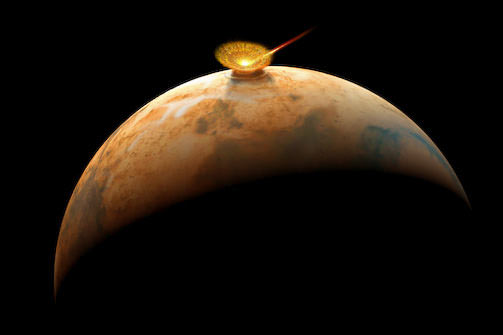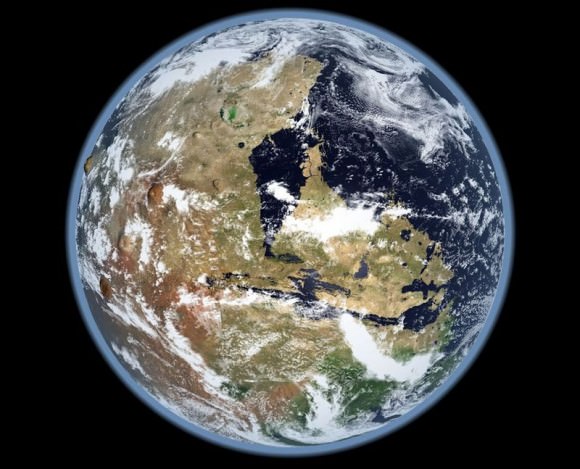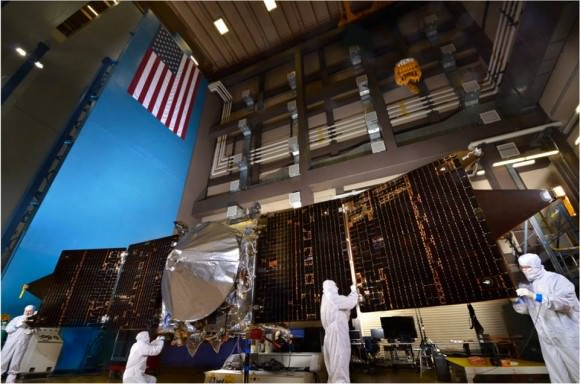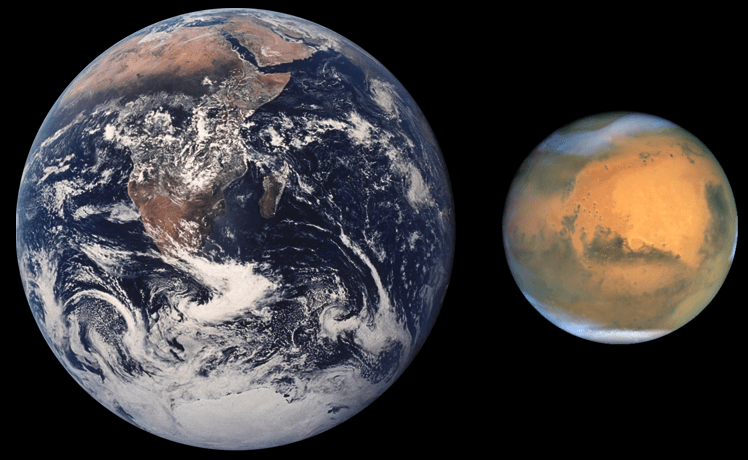Are Earthlings really Martians ?
Did life arise on Mars first and then journey on rocks to our planet and populate Earth billions of years ago? Earth and Mars are compared in size as they look today. NASA’s upcoming MAVEN Mars orbiter is aimed at answering key questions related to the habitability of Mars, its ancient atmosphere and where did all the water go.
Story updated[/caption]
Are Earthlings really Martians?
That’s the controversial theory proposed today (Aug. 29) by respected American chemist Professor Steven Benner during a presentation at the annual Goldschmidt Conference of geochemists being held in Florence, Italy. It’s based on new evidence uncovered by his research team and is sure to spark heated debate on the origin of life question.
Benner said the new scientific evidence “supports the long-debated theory that life on Earth may have started on Mars,” in a statement. Universe Today contacted Benner for further details and enlightenment.
“We have chemistry that (at least at the level of hypothesis) makes RNA prebiotically,” Benner told Universe Today. “AND IF you think that life began with RNA, THEN you place life’s origins on Mars.” Benner said he has experimental data as well.
First- How did ancient Mars life, if it ever even existed, reach Earth?
On rocks violently flung up from the Red Planet’s surface during mammoth collisions with asteroids or comets that then traveled millions of miles (kilometers) across interplanetary space to Earth – melting, heating and exploding violently before the remnants crashed into the solid or liquid surface.

“The evidence seems to be building that we are actually all Martians; that life started on Mars and came to Earth on a rock,” says Benner, of The Westheimer Institute of Science and Technology in Florida. That theory is generally known as panspermia.
To date, about 120 Martian meteorites have been discovered on Earth.
And Benner explained that one needs to distinguish between habitability and the origin of life.
“The distinction is being made between habitability (where can life live) and origins (where might life have originated).”
NASA’s new Curiosity Mars rover was expressly dispatched to search for environmental conditions favorable to life and has already discovered a habitable zone on the Red Planet’s surface rocks barely half a year after touchdown inside Gale Crater.
Furthermore, NASA’s next Mars orbiter- named MAVEN – launches later this year and seeks to determine when Mars lost its atmosphere and water- key questions in the Origin of Life debate.

Of course the proposed chemistry leading to life is exceedingly complex and life has never been created from non-life in the lab.
The key new points here are that Benner believes the origin of life involves “deserts” and oxidized forms of the elements Boron (B) and Molybdenum (Mo), namely “borate and molybdate,” Benner told me.
“Life originated some 4 billion years ago ± 0.5 billon,” Benner stated.
He says that there are two paradoxes which make it difficult for scientists to understand how life could have started on Earth – involving organic tars and water.
Life as we know it is based on organic molecules, the chemistry of carbon and its compounds.
But just discovering the presence of organic compounds is not the equivalent of finding life. Nor is it sufficient for the creation of life.
And simply mixing organic compounds aimlessly in the lab and heating them leads to globs of useless tars, as every organic chemist and lab student knows.
Benner dubs that the ‘tar paradox’.
Although Curiosity has not yet discovered organic molecules on Mars, she is now speeding towards a towering 3 mile (5 km) high Martian mountain known as Mount Sharp.

Curiosity will ascend mysterious Mount Sharp and investigate the sedimentary layers searching for clues to the history and habitability of the Red Planet over billions of years. This mosaic was assembled from over 3 dozen Mastcam camera images taken on Sol 352 (Aug 2, 2013. Credit: NASA/JPL-Caltech/MSSS/ Marco Di Lorenzo/Ken Kremer-kenkremer.com
Upon arrival sometime next spring or summer, scientists will target the state of the art robot to investigate the lower sedimentary layers of Mount Sharp in search of clues to habitability and preserved organics that could shed light on the origin of life question and the presence of borates and molybdates.
It’s clear that many different catalysts were required for the origin of life. How much and their identity is a big part of Benner’s research focus.
“Certain elements seem able to control the propensity of organic materials to turn into tar, particularly boron and molybdenum, so we believe that minerals containing both were fundamental to life first starting,” says Benner in a statement. “Analysis of a Martian meteorite recently showed that there was boron on Mars; we now believe that the oxidized form of molybdenum was there too.”
The second paradox relates to water. He says that there was too much water covering the early Earth’s surface, thereby causing a struggle for life to survive. Not exactly the conventional wisdom.
“Not only would this have prevented sufficient concentrations of boron forming – it’s currently only found in very dry places like Death Valley – but water is corrosive to RNA, which scientists believe was the first genetic molecule to appear. Although there was water on Mars, it covered much smaller areas than on early Earth.”

I asked Benner to add some context on the beneficial effects of deserts and oxidized boron and molybdenum.
“We have chemistry that (at least at the level of hypothesis) makes RNA prebiotically,” Benner explained to Universe Today.
“We require mineral species like borate (to capture organic species before they devolve to tar), molybdate (to arrange that material to give ribose), and deserts (to dry things out, to avoid the water problem).”
“Various geologists will not let us have these [borates and molybdates] on early Earth, but they will let us have them on Mars.”
“So IF you believe what the geologists are telling you about the structure of early Earth, AND you think that you need our chemistry to get RNA, AND IF you think that life began with RNA, THEN you place life’s origins on Mars,” Benner elaborated.
“The assembly of RNA building blocks is thermodynamically disfavored in water. We want a desert to get rid of the water intermittently.”
I asked Benner whether his lab has run experiments in support of his hypothesis and how much borate and molybdate are required.
“Yes, we have run many lab experiments. The borate is stoichiometric [meaning roughly equivalent to organics on a molar basis]; The molybdate is catalytic,” Benner responded.
“And borate has now been found in meteorites from Mars, that was reported about three months ago.
At his talk, Benner outlined some of the chemical reactions involved.
Although some scientists have invoked water, minerals and organics brought to ancient Earth by comets as a potential pathway to the origin of life, Benner thinks differently about the role of comets.
“Not comets, because comets do not have deserts, borate and molybdate,” Benner told Universe Today.

Benner has developed a logic tree outlining his proposal that life on Earth may have started on Mars.
“It explains how you get to the conclusion that life originated on Mars. As you can see from the tree, you can escape that conclusion by diverging from the logic path.”
Finally, Benner is not one who blindly accepts controversial proposals himself.
He was an early skeptic of the claims concerning arsenic based life announced a few years back at a NASA sponsored press conference, and also of the claims of Mars life discovered in the famous Mars meteorite known as ALH 84001.
“I am afraid that what we thought were fossils in ALH 84001 are not.”
The debate on whether Earthlings are really Martians will continue as science research progresses and until definitive proof is discovered and accepted by a consensus of the science community of Earthlings – whatever our origin.
On Nov. 18, NASA will launch its next mission to Mars – the MAVEN orbiter. Its aimed at studying the upper Martian atmosphere for the first time.
“MAVENS’s goal is determining the composition of the ancient Martian atmosphere and when it was lost, where did all the water go and how and when was it lost,” said Bruce Jakosky to Universe Today at a MAVEN conference at the University of Colorado- Boulder. Jakosky, of CU-Boulder, is the MAVEN Principal Investigator.
MAVEN will shed light on the habitability of Mars billions of years ago and provide insight on the origin of life questions and chemistry raised by Benner and others.
…………….
Learn more about Mars, the Origin of Life, LADEE, Cygnus, Antares, MAVEN, Orion, Mars rovers and more at Ken’s upcoming presentations
Sep 5/6/16/17: “LADEE Lunar & Antares/Cygnus ISS Rocket Launches from Virginia”; Rodeway Inn, Chincoteague, VA, 8 PM
Oct 3: “Curiosity, MAVEN and the Search for Life on Mars – (3-D)”, STAR Astronomy Club, Brookdale Community College & Monmouth Museum, Lincroft, NJ, 8 PM
Oct 9: “LADEE Lunar & Antares/Cygnus ISS Rocket Launches from Virginia”; Princeton University, Amateur Astronomers Assoc of Princeton (AAAP), Princeton, NJ, 8 PM


That’s… “Chemist’s New Clam Sparks Controversy”
Hate to seem pedantic but when I see articles with simple grammatical errors like that it makes it look like something my 12 yo niece wrote.
I dunno. The whole thing sounds like a bunch of sciency-sounding buzzwords and not a lot of substance.
“So how much borate and molybdate do you need?”
“Stochiometry! Catalyst! I have a logic tree!”
Give me a break.
We have to find life or evidence of past life on Mars before we can go about theorizing coming from there.
I still think people are following this line of thought more out of “It would be cool if we came from Mars” than out of they have hard evidence to think this was the case.
No, in that I agree with Benner, for hypothesis testing it is enough to be able to make constraints that goes into the test. And I can see why he wants to include Mars, even if he is skipping some of the data that we do have on the Archean continental crust.
But his hypothesis doesn’t seem to stand up well.
So he’s come up with a hypothetical prebiotic pathway to RNA and is drawing conclusions about the origin of life as if it were settled science. He doesn’t even know whether his hypothetical pathway can actually produce RNA, much less whether it was the path that actually led to life on Earth. He’s getting way ahead of himself here, verging on wild speculation.
But I suppose it did get him all over the web, so…
news today from multiple MSM sources is claiming that we likely, i’ll repeat with caps… LIKELY… came from Mars. i always try to be tolerant of silly things that cause otherwise disintersted folks to look up to the sky: UFOs, alien abductions, etc… but i have my limits.
there is a possibility that it is true of course, but not only is it not “likely”, it’s highly improbable given the current amount of evidence and discovery. please tell me that you more educated people on this site are not buying into this mcdonald’s science.
“We have to find life or evidence of past life on Mars before we can go about theorizing coming from there.”
We have to find RNA based life on Mars. DNA based life only happened on Earth after the RNA arrived from Mars. Or have I misunderstood whats being said.
Pretty much Michael but immaterial on whether RNA transmuted to DNA on Mars or Earth. Obviously, it wasn’t a small dinosaur that rode that explosion all the way to Earth so the simpler the life or precursor-to-life, the more likely it would survive the initial explosion, the years in space and then the descent to earth. Hearty bugger eh? Glad it wasn’t up to me!
So Ray Bradbury was right. 🙂
This is basically a “God of the gaps” type argument – because I don’t understand how life originated on Earth, it must have originated on Mars. Nonsense! This guy’s so-called “logic tree” is so full of gaps and huge assumptions that I don’t know how this self-proclaimed “skeptic” is able to come up with this theory. We don’t know how life began, whether it began with RNA or some other process, we don’t know what chemistry was needed to make life begin, etc…
I’m not saying that life didn’t evolve on Mars and then somehow get to Earth, but it is a very, very, very unlikely scenario. Invoking Occam’s razor, I would conclude that a much simpler explanation is that life evolved on Earth, until, of course, we have more research on which to make an informed decision.
Indeed. That someone would proclaim themselves to be a skeptic and then spin a load of unsupported drivel like this to the media is absurd. It’s not that the *idea* is bad, it’s that he’s supporting a wild, clueless, evidenceless guess as if it were the only possible conclusion. To Benner I say: welcome to the same level of stupid over-the-top rhetoric as as Richard Hoagland.
Benner has, and show us, his evidentiary support. Some seems mistaken though.
Dunno what everyone is saying, but when I skipped down to his own words, he had a lot of if’s and qualifications. He’s clearly working on a speculative theory under a few assumptions.
Nothing preventing a skeptic from speculating. That’s an essential part of science.
If Occam’s razor can lead you to produce replicable DNA or RNA in the lab using primordial ingredients and conditions, then more power to you. The only scientific consensus so far is that it’s possible, as the product isn’t too different from the ingredients.
As for acting like we know what happened or about real-world, unconditional probabilities of what might have happened, he doesn’t seem guilty. The media needs a story and certainty sells.
Total nonsense.
If I’d created that image of Mars-of-livelier-days, I wouldn’t have been able to help but have at least one of the volcanoes smoking, or more.
I have a huge respect for Benner after the “arsenic life” debacle, as he pointed out how unfeasible and unevidenced the hypothesis was. But this is an old idea of his: “In point of fact, I happen to believe that molybdenum is essential for life, and molybdenum is much more scarce than either silicon or carbon. Boron might also be essential to life, and that is still less abundant.” (2006, http://www.spacedaily.com/reports/Debating_The_Boundaries_Of_Life_999.html ) And it haven’t panned out well what I know of.
– Boron is supposed to stabilize the ribose in RNA under salty (ocean) conditions. But before it was found in martian meteorites it was only known from Earth: “Boron is commonly found in clay sediments found on Earth.” [ http://www.natureworldnews.com/articles/2376/20130611/martian-meteorite-shows-tpresence-boron-helps-build-rna.htm ] And today we have evidence that ribose and the nucleotide bases is stabilized, and stabilizes, the lipids that was produced in the environment of early protocells. [ http://www.pnas.org/content/early/2013/07/29/1300963110 ]
– Molybden I know less about, but googling the first poster describes how molybden was plentiful and presumably of the same oxidation state in the early Archean as today: “We suggest the geochemical cycle of Mo during the Archean-Paleoproterozoic time was essentially the same as today: Mo-bearing minerals were quantitatively oxidized during weathering, dissolved Mo was transported to the oceans, and it was fixed by C_org and sulfide S in locally anoxic marine environments.” [ “MOLYBDENUM GEOCHEMICAL CYCLE IN THE ARCHEAN”, Yamaguchi, 2002 Denver Annual Meeting ; https://gsa.confex.com/gsa/2002AM/finalprogram/abstract_44043.htm ]
The concentration of organics under the Hadean was presumably diluted outside of alkaline hydrothermal vents. They may have gummed up some surfaces, but not all.
– We do know the Hadean had weathered (continental) crust. [Ushikubo et al 2008, “Lithium in Jack Hills zircons: Evidence for extensive weathering of Earth’s earliest crust”; http://www.geology.wisc.edu/~wiscsims/pdfs/Ushikubo_EPSL2008.pdf ; HT: barakn]
In sum, the 3 proposed tests for conditions under the hypothesis all falls. Meaning the likelihood for local abiogenesis seems to have been good enough on Earth. Transpermia remains the less likely pathway, an easy enough estimate from known experiments. [As I have described on UT before.]
That is a bit ironic, considering our countries proclivity for wars.
What’s up .Let me have a break.
Space is full of seeds…all they need is the right place to land…